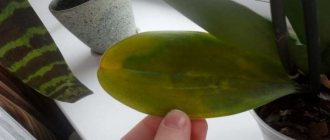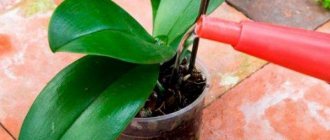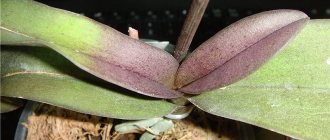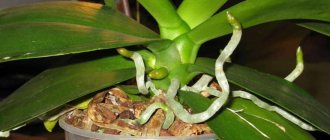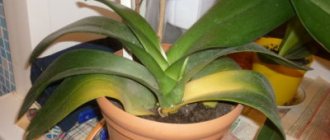An orchid is an incredibly beautiful, but whimsical and capricious flower to care for. The natural habitat of this unusual representative of the fauna is a tropical climate. It is quite difficult to reproduce such conditions at home. The lack of a favorable microclimate becomes the main reason that even an adult and blooming orchid begins to wither and then, if no measures are taken, dies. Therefore, the condition of the orchid must be constantly monitored.
Growing an exotic beauty on a windowsill requires a lot of time and effort to simply part with your favorite specimen. It is much easier and simpler to take a number of measures to resuscitate a diseased orchid. You can even save a plant that has lost its foliage. If you do everything correctly, then very soon it will once again become the main decoration of the window sill, delighting you with its sophisticated and delicate beauty. The main thing is to take all necessary recovery measures in a timely manner.
Natural aging of orchid foliage
Not all foliage problems are caused by improper care. We must not forget about the natural physiological and inevitable aging of foliage. It is characterized by yellowing of the plate. To be sure that aging is the reason for the loss of foliage, it is necessary to take into account what species the orchid belongs to. The leaves of the exotic beauty usually die off in the third month of their existence. Early falling off is typical only for dendrobium. It occurs during a period of rest. Monopodial species, among which phenopolis is the most common and grown on window sills, as a rule, do not lose all their foliage. It is considered normal for them to die off of only two leaves, which are lower than the others. Any other drop is not natural, but serves as a signal of concern about the health of the orchid.
Yellowness, accompanied by lethargy and flabbiness, is not physiological aging, but most likely overheating. To prevent the orchid from losing its leaves, it is removed from the windowsill, and after three to four hours it is sprayed and watered with settled water. On the fourth or fifth day the plant will come to its senses, but it needs to be placed in a new place.
Strengthening drugs
Another effective way to revive an orchid without leaves is to use various strengthening drugs. They can be used to treat the remaining root of the plant.
These drugs include primarily growth regulators, which help strengthen the flower’s immunity. The most commonly used drugs are Epin and Zircon. It is worth noting that the remaining roots of the flower need to be treated with a solution of a certain concentration. The instructions for each such drug contain a clear description of the preparation of the solution. One orchid can be periodically treated with different means.
After treatment with such preparations, the plant will regain its strength for the further formation of new leaves and flowering. However, such treatment is not a panacea. If an orchid's leaves have fallen, an integrated approach should be taken to resuscitate it. This approach to reanimated flowers will quickly normalize the condition of plants and create the necessary growing conditions for them. You may have to wait a longer period to achieve flowering.
For what reasons does an orchid lose its leaves?
Loss of foliage in orchids is most often associated with improper care. There are a huge number of points, each of which must be followed. Otherwise, an exotic and capricious flower may be left without leaves. The bareness of the stem in orchids is usually directly related to the condition of the root system. Often, novice gardeners overwater the plant. This is due to the erroneous assumption that orchids love moisture. In its natural habitat, this exotic representative of the flora actually grows along the coastline of reservoirs, in tropical forests, on sea slopes or in gorges. Its roots are never completely immersed in water. If you water an orchid too much at home, the root system will simply begin to rot. Therefore, moisture stagnation in the soil should not be allowed. When a plant has not been watered for some reason for a long time, the best way to prevent excessive flooding is to dip the roots in water for 10 minutes and then spray the foliage.
How to propagate using roots?
Orchids can be propagated in different ways. However, it is necessary to familiarize yourself with the basics. You should not use young plants, as they will be difficult to separate. In addition, the young plant may even die. You can do everything correctly with either peroxide or a solution of potassium permanganate.
Through the roots
Dividing is allowed only half a month after the orchid has faded. When dividing, all roots must be absolutely healthy, and each of the divided parts must have several pseudobulbs (at least two). The more of them there are, the more successful the division will be, which means the plant will be able to take root faster.
The first thing to do is take the orchid out of the pot and clean it of soil. To do this, you can gently shake the plant, and the excess substrate will fall off on its own. Next, the orchid roots need to be placed in water heated to room temperature. They should stay there for about half an hour. Then, using a very sharp knife, you need to cut the root, and then divide the orchid into two parts.
The cut areas should be sprinkled with either ground cinnamon or activated carbon, crushed into powder. Then the plant should be left for 2-3 hours so that the roots dry out a little. After this, both separated parts can be planted in separate pots with soil prepared in advance. It can be with or without sphagnum moss.
After transplanting an orchid, you need to carefully monitor it. Watering is best done in the form of spraying.
Aerial shoots
Orchids also reproduce by the air method. If the flower has many silvery aerial roots, then they can be used for propagation. For this purpose, you need to select the strongest root that appears and carefully, without cutting it from the stem, place it on a layer of moss in the same pot. Before this, the moss must be slightly moistened. Then a small incision must be made in the spine and treated with a special stimulant. At the site of the cut, a shoot should appear, which within a month will have small roots.
After they appear, the baby can be cut off from the main plant and the cut area can be sprinkled with cinnamon or charcoal. The cut should be no further than one centimeter from the main root. Now you can transplant it into a separate pot, which will be slightly smaller in size. To quickly grow a good root system in a new plant, you can make a homemade greenhouse. To do this, cover the shoot with a plastic glass cut on the side and create a greenhouse effect.
The moss must be regularly moistened so that the young orchid can grow and develop quickly.
Reanimation of an orchid without leaves
There are several ways to save an exotic tropical plant from death. Which method to resort to depends on the condition of the orchid itself and the availability of free time. The latter is the most important point. If you violate any point of the rehabilitation process, all efforts will be reduced to a minimum. Since the most common cause of foliage loss is flooding of the root system, so that rotting does not spread to the foliage, the orchid must be removed from the pot. Shake off the soil from the rhizome and dip it in a basin filled with warm water for exactly ten minutes. Not a minute more, not a minute less.
Lack of lighting
To save your orchid from death and stimulate it to grow young leaves, you need to worry about its optimal lighting. Experts, as a rule, recommend placing the flower in a pot on the windowsill. However, be careful: the orchid does not like direct sunlight. If you decide to place it on the windowsill, then try to shade the plant after 9–10 am. Otherwise, burns will appear on the leaves, and there will be nothing to think about the active growth of young leaf blades.
In winter, it is worth taking care of additional artificial lighting of the flower. Place a phytolamp over the green specimen to provide additional illumination.
It's always quite easy to go overboard with lighting conditions. This is why novice gardeners have certain difficulties with orchids. To avoid them, try to control the length of daylight hours on your own.
It is recommended to illuminate the plant for no more than 12–14 hours. That is why in summer it is advisable to shade the flower specimen, and in winter try to illuminate the orchid additionally. In this case, it will develop fully, and new leaves will appear at the right time.
A simple way to save an orchid
It is recommended to resort to it only under favorable conditions for the tropical beauty. This means that it is kept at an optimal level of air humidity and good light. Both of these factors must correspond to the orchid variety. No deviations are allowed. The stalk that remains without leaves is planted directly in the moss. Watering must be correct. For each, only one tablespoon of settled water is enough. Moisture is absorbed by the moss and distributed evenly, and, therefore, the plant receives the amount of liquid it needs. This method is quite simple, but not always effective, since it is very difficult to recreate ideal conditions. They resort to it most often when the plant has simply been flooded or taken by a stem without leaves.
You can plant the rescued plant in a new container when the stem gets stronger and the root system begins to grow, which indicates that the orchid feels great in the moss. The main thing is that the container is located correctly, that is, in a place where the tropical beauty will not be in danger of overheating, hypothermia or drafts.
The second method of plant resuscitation
The orchid is pulled out of the water. Wait for the plant to dry completely. The root system is examined and assessed. Rotten shoots and leaves are removed with sharp scissors, pruning shears, or a blade. The instrument is pre-treated for sterilization. The cut areas are sprinkled with powder. It is prepared from ground cinnamon or charcoal. If the inanimate elements are not removed, the flowers will continue to rot. Leaving damaged areas will nullify all efforts to save the orchid.
The flower, cleared of leaves and damaged roots, is placed in a greenhouse. It can be purchased at a specialty store or made from a plastic container with transparent walls. The bottom is laid out with expanded clay and moss. The orchid is “planted” from above and covered with a lid. The main requirement for keeping an orchid in a greenhouse is the temperature regime. It should not be higher than +33 degrees. If the temperature is higher, rotting will resume. At night, the temperature should be kept between +20 and +25 degrees.
Preventive measures to prevent orchid leaf loss
Neither the leaves nor the root system will rot if the appropriate care rules are followed. The first and most important thing comes down to the fact that the orchid calmly tolerates dry soil, but rots when water stagnates at the bottom of the container.
It is quite difficult for novice gardeners to determine when the soil needs additional moisture. A plastic pot will be an excellent helper in watering. Its transparent walls will be an excellent guide for monitoring the condition of the rhizome, so as not to dry out or flood the soil.
Orchids get sick not only due to overheating, but also due to lack of lighting. In both cases, the plant requires a change of residence. Otherwise, resuscitation of the flower will not be successful. You cannot place an orchid on a window without curtains or blinds, or next to heating devices that are not covered with a shield. This will cause overheating.
The best choice would be to place the orchid on a special stand. It should be located near a window oriented to the southeast or southwest. The main thing is that direct rays do not fall on the foliage of the flower. Otherwise, the plates will get burned, which will cause them to fall off.
Watering errors
Very often, the key reason for the absence of young leaves of a plant lies in improper moistening of the substrate. In winter, for example, due to the turned on radiators and heaters, the air in the apartment is excessively dry. Because of this, your orchid may too quickly lose the moisture with which you have saturated its soil. That is why it is advisable to water it at least twice a week.
The best option is, in addition to regular irrigation of the soil composition, do not forget about spraying the flower. It is recommended to do it every other day. There is an alternative choice: moisten the air rather than the plant itself. The humidity in the room should be maintained at medium level.
Improper watering often leads to rotting of the substrate or drying out. However, it is quite possible to resolve this situation in time. To do this, simply inspect your home plant. If the lower foliage has turned yellow, become too soft and watery, it is better to take a pause between moistening the soil.
Take special care about the quality of the water. It is advisable to leave it for several days. In this case, the chlorine components will simply settle to the bottom. It is also necessary to irrigate the soil composition with water at room temperature. This way you will take proper care of your houseplant.


